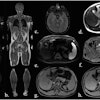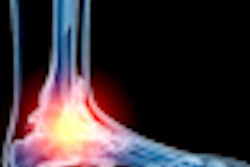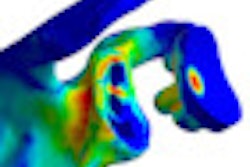
As the summer months start to loom large, get prepared to see more images of trampoline injuries. Failure to spot fractures can cause long-term health problems for younger patients, Norwegian researchers warn.
"The number of trampoline-related injuries has increased over the past years," noted Dr. Fredrik Wexels, a radiologist at Drammen Hospital, Drammen, about 20 km southwest of Oslo. "It is important to note that fractures of the long bones in children and adolescents can lead to growth failure. Guidelines for safe use of trampolines are often not followed and this may be the reason for the high number of injuries."
 Trampolining is a popular summer activity, but it carries a risk of serious injury because people don't tend to follow safety guidelines, according to experts.
Trampolining is a popular summer activity, but it carries a risk of serious injury because people don't tend to follow safety guidelines, according to experts.
The hospital provides care for about 150,000 inhabitants. Between 2008 and 2010, 273 patients were referred to the radiology department after trampoline accidents, comprising155 males and 118 females. The median age was 10 years, and the age distribution ranged from 2 to 44 years, stated Wexels, who presented his findings at the 2012 European Congress of Radiology (ECR).
Using predominantly radiography, a total of 106 positive radiological findings were detected. About 19% of the injured patients were aged between 11 and 12. The distribution between positive and negative radiological findings was quite similar across the various age groups, except for 7- and 8-year-olds, among whom there was a higher proportion of negative findings, he reported.
The ankle, foot, and elbow were the most common anatomic sites of injury, while injuries to the hand, wrist, and forearm had the highest number of positive radiological findings (see table). Ultrasound of the abdomen was performed in two patients with normal findings. More than three-quarters of the injuries occurred between May and August.
Anatomic localization and number of radiological examinations
|
||||||||||||||||||||||||||||||||||||||||||||||||||||||||||||||||||||||||
| Source: Trampoline accidents registered by a department of radiology, a three-year material. F. Wexels and T.E. Gudmundsen, Drammen Hospital, Norway. Presented at ECR 2012. |
Wexels and his co-author -- Dr. Tor Erik Gudmundsen, associate professor of radiology at Drammen Hospital -- also studied the incidence of sledging-related injuries.
"Sledges can achieve high speed, they can be difficult to control, and rapid deceleration is often not possible. It is usually children who sledge and the slopes are often unprepared and unsupervised," they pointed out. "Although the availability of sledges is high and the speed potential is great, it seems little attention is paid to the potential risk. There are few guidelines for safe use of sledges or harm reduction recommendations. The risk of injury can possibly be reduced if the areas for sledging are organized to avoid collisions with other sledges and stationary objects."
Over the same three-year period, 193 patients were referred to the hospital after sledging accidents, consisting of 110 men and 83 women. The median age was 11 years, and the age distribution was from 2 to 72 years.
In all, 84 positive radiological findings were detected in 80 patients. More men than women were injured, and men had a higher proportion of positive radiological findings. Most injured patients were aged from 5 to 14 years, and this group represented 66% of the patients. The distribution between positive and negative radiological findings was quite similar, except in the age group of 10-14 years, among whom there were a substantially higher proportion of negative findings.
Falling off the sledge was cited as the main mechanism of injury, but a large proportion of the injury mechanisms were unknown. Injuries of the hand and wrist had the highest proportion of positive radiological findings. In addition, 12 examinations of the thorax were conducted, after which one patient was diagnosed with pneumothorax and two patients had findings consistent with hemothorax. Ultrasound of the abdomen was performed in two patients with normal findings, the authors reported.
Five patients had multiple injuries requiring hospitalization. Of these, two patients had a columna vertebral fracture, and two patients had hemothorax and cerebral contusion bleeding. The last patient had multiple injuries, including pneumothorax and hip dislocation. There were no fatal accidents.
The number of patients referred during this period rose from 50 in 2008 to 63 in 2009 and 80 in 2010. The number of positive radiological findings showed little change and was respectively 24, 26, and 30.
"In our material, sledging accidents represent 10% of all injuries caused by sport and leisure activities. Most of the positive radiological findings were fractures that could be treated in an ambulatory fashion. Serious injuries and fatalities occur but most patients do not require hospitalization," they concluded.



















